Imagine speeding up your keyword research, content planning, and technical audits with a few simple commands—welcome to the world of SEO AI prompts. For digital marketers and content creators, these powerful instructions transform generative AI tools from interesting novelties into essential productivity engines. But what exactly are these prompts, and how can they revolutionize your search optimization efforts?
AI prompts function as specific instructions that guide artificial intelligence systems to produce targeted, useful outputs. When crafting prompts for tools like ChatGPT, your wording, structure, and context significantly impact the quality of results. This concept, known as prompt engineering, represents the difference between receiving generic information and obtaining actionable, SEO-focused insights that drive real results.
The beauty of ChatGPT prompts for SEO lies in their versatility and efficiency. Throughout this guide, we’ll explore ten practical prompts designed to enhance every aspect of your optimization strategy—from comprehensive keyword research and content structure planning to technical audits and competitor analysis. Each prompt serves as a template you can customize for your specific needs, saving hours of manual work while potentially uncovering opportunities you might otherwise miss. Ready to transform your SEO workflow? Let’s dive into these game-changing prompts.
What is a Prompt in AI?
A prompt essentially works as the input text that directs generative AI models to produce specific outputs. In a way, prompts function as conversation starters that establish boundaries for what we want the AI to create. The quality of our prompt directly influences how useful the AI’s response will be. For instance, a basic prompt like “Tell me about SEO” typically generates broad information. However, asking “Create a list of 5 technical SEO factors that impact page speed with explanations” delivers focused, actionable insights.
Prompts actually range from simple questions to detailed, multi-part instructions. According to McKinsey, organizations now recognize the strategic value of generative AI tools. One-third already use them regularly in their operations. This rapid adoption highlights why understanding prompt construction matters for anyone working with AI systems.
The Anatomy of an Effective AI Prompt
Effective prompts generally contain three key elements that work together. First, they establish context by telling the AI what role to assume. Second, they provide clear instructions about the desired output. Third, they often include format specifications or examples. Research from MIT Sloan on prompt engineering suggests that context specificity significantly improves response quality. Here are the essential components we should include:
- Role assignment (e.g., “Act as an SEO specialist”)
- Task description (e.g., “Analyze these keywords for search intent”)
- Output format (e.g., “Present results in a table with three columns”)
How AI Interprets and Responds to Prompts
Behind the scenes, AI models process our prompts through tokenization. This means breaking text into smaller units for analysis within their context windows. Each model has limitations in how much information it can process at once. Models also carry inherent biases based on their training data.
The process rarely produces perfect results on the first attempt. Successful prompt crafting typically involves several refinement cycles. We adjust our instructions based on initial outputs to overcome the model’s limitations. As generative AI capabilities expand, organizations increasingly create dedicated prompt engineering roles. This trend reflects the growing importance of prompt expertise in business operations.
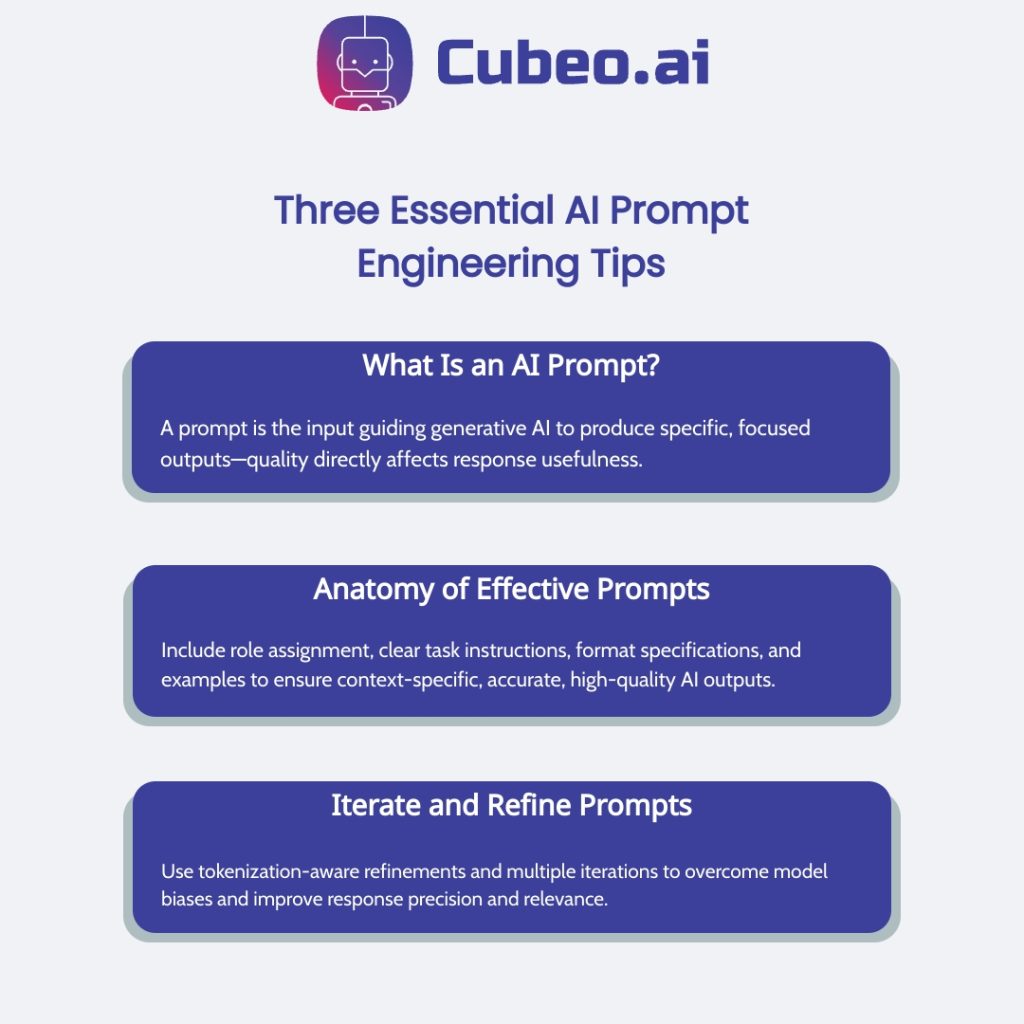
Understanding Prompt Engineering for SEO
Prompt engineering shapes how AI tools deliver SEO-focused results through carefully designed instructions. This skill helps marketers extract maximum value from AI systems when creating content, researching keywords, or analyzing competitors. Effective prompts require both technical knowledge and creative thinking to generate outputs that satisfy search algorithms and human readers alike.
Context matters tremendously when crafting SEO AI prompts. Generic requests produce mediocre results, while detailed instructions yield actionable insights. This concept aligns perfectly with the dual SEO and LEO approach from Cubeo AI, which optimizes content for traditional search engines and large language models simultaneously. Their framework shows how well-engineered prompts create content that performs across multiple discovery channels.
Key Principles of Effective Prompt Engineering
Creating powerful prompts follows several practical guidelines:
- Use direct language with measurable requests (“Find 10 keywords with 1,000+ monthly searches”)
- Add background about your market and audience goals
- Show examples of your preferred output format
- Define tone, length, and style requirements
Testing various prompt versions helps discover what works best for your specific needs. Small wording changes can dramatically improve results, so consider prompt creation an ongoing process rather than a one-time task.
Common Mistakes to Avoid in Prompt Engineering
Many marketers make common errors when first working with AI prompts. Too-general requests waste time sorting through unhelpful information. For instance, asking “How do I improve SEO?” gets generic advice, while “List five technical fixes for WordPress site speed” delivers focused recommendations.
Overlooking model limitations also causes problems. AI systems process limited text amounts at once, so extremely detailed prompts might get truncated. Breaking complex questions into smaller parts often works better. Finally, accepting initial outputs without refinement limits potential value. Successful prompt engineers view first results as starting points, continuously improving their instructions based on quality and relevance.
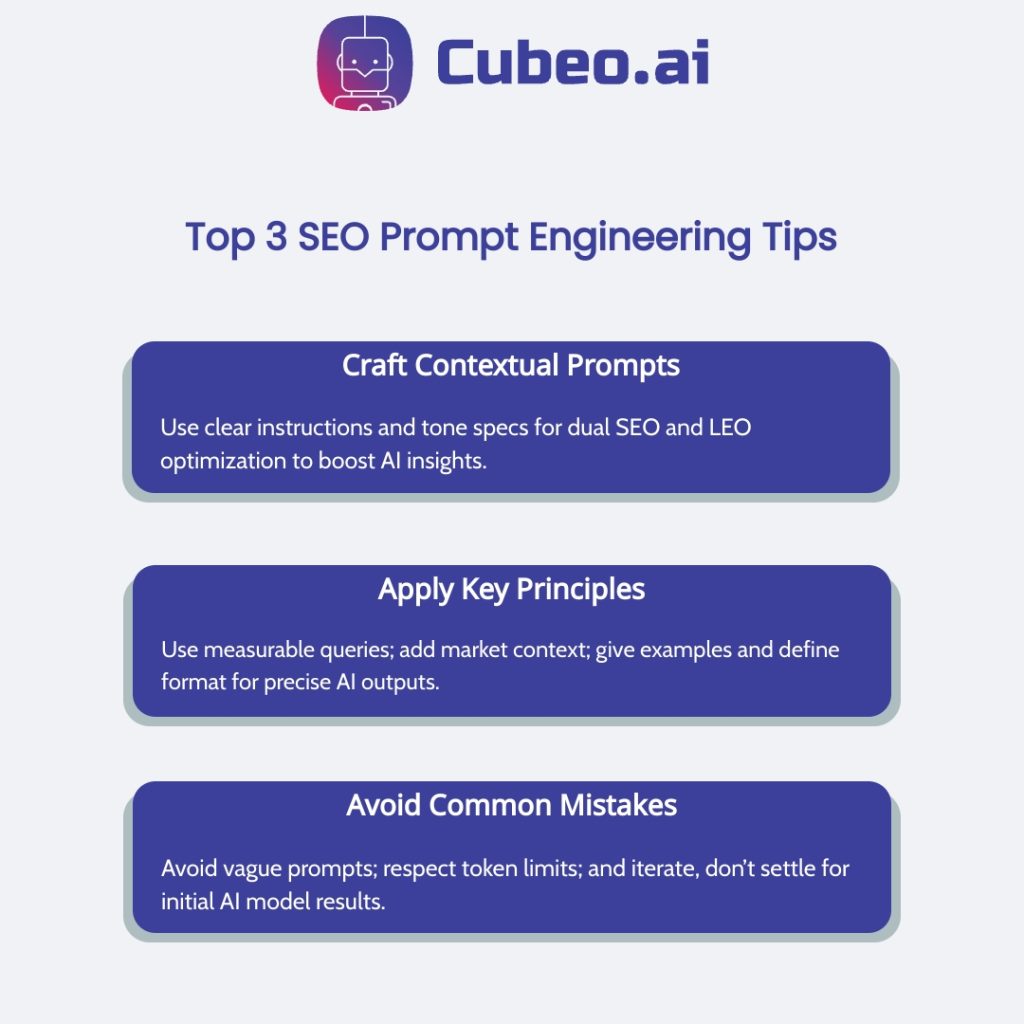
10 Powerful AI Prompts for SEO
With 86% of SEO professionals now using AI in their strategies, quality prompts have become crucial for digital success. Our collection of 10 SEO AI prompts spans the complete optimization cycle from keyword research to technical audits.
These prompts follow a logical progression that matches typical SEO workflows:
- Research and planning prompts
- Content creation templates
- Technical optimization guides
- Performance analysis frameworks
Start by incorporating one prompt into your routine, then gradually add more as you get comfortable. This approach pays off quickly, as 65% of businesses see better SEO results with AI assistance. For maximum efficiency, save these prompts in your favorite AI tool for quick access during daily SEO tasks.
Prompt #1 Comprehensive Keyword Research
Keyword research builds the foundation for SEO success, and over 70% of marketers currently use AI tools to enhance this process. Our first prompt converts ChatGPT into a keyword discovery engine that produces targeted keyword lists quickly.
Prompt Template:
Act as an SEO keyword research specialist. Generate a comprehensive list of 20 long-tail keywords related to [YOUR TOPIC] with monthly search volumes exceeding [MINIMUM VOLUME]. For each keyword, provide:
- The exact keyword phrase
- Estimated monthly search volume
- Keyword difficulty score (low/medium/high)
- Search intent classification (informational/navigational/transactional)
- A brief content suggestion that would rank well for this keyword
This method delivers blindspot-free keyword research by revealing terms traditional tools might miss. Cubeo AI’s no-code tool development process lets marketers run comprehensive keyword prompts without coding knowledge, making advanced research accessible to everyone.
How to Customize This Prompt for Your Niche
Adapt this prompt for your needs by adjusting these parameters:
- Replace [YOUR TOPIC] with your focus area (like “organic gardening supplies”)
- Set [MINIMUM VOLUME] based on traffic goals (100 for newer sites, 1,000+ for established ones)
- Add geographic qualifiers (“in Chicago” or “UK market”)
- Specify content types (“blog topics” or “product keywords”)
B2B markets benefit from industry-specific qualifiers that target decision-makers directly.
Analyzing the AI Output for Actionable Insights
When reviewing your keyword lists, look beyond just search volumes. Group related terms into topic clusters to identify content themes. Prioritize keywords that align with your business goals—a well-matched term with 300 monthly searches often performs better than loosely related terms with higher volumes.
Focus on keywords showing informational intent with commercial elements, such as “best organic fertilizer for tomatoes.” Research shows 65% of marketers achieve better SEO results with AI tools for finding these high-conversion opportunities that traditional tools might categorize incorrectly.
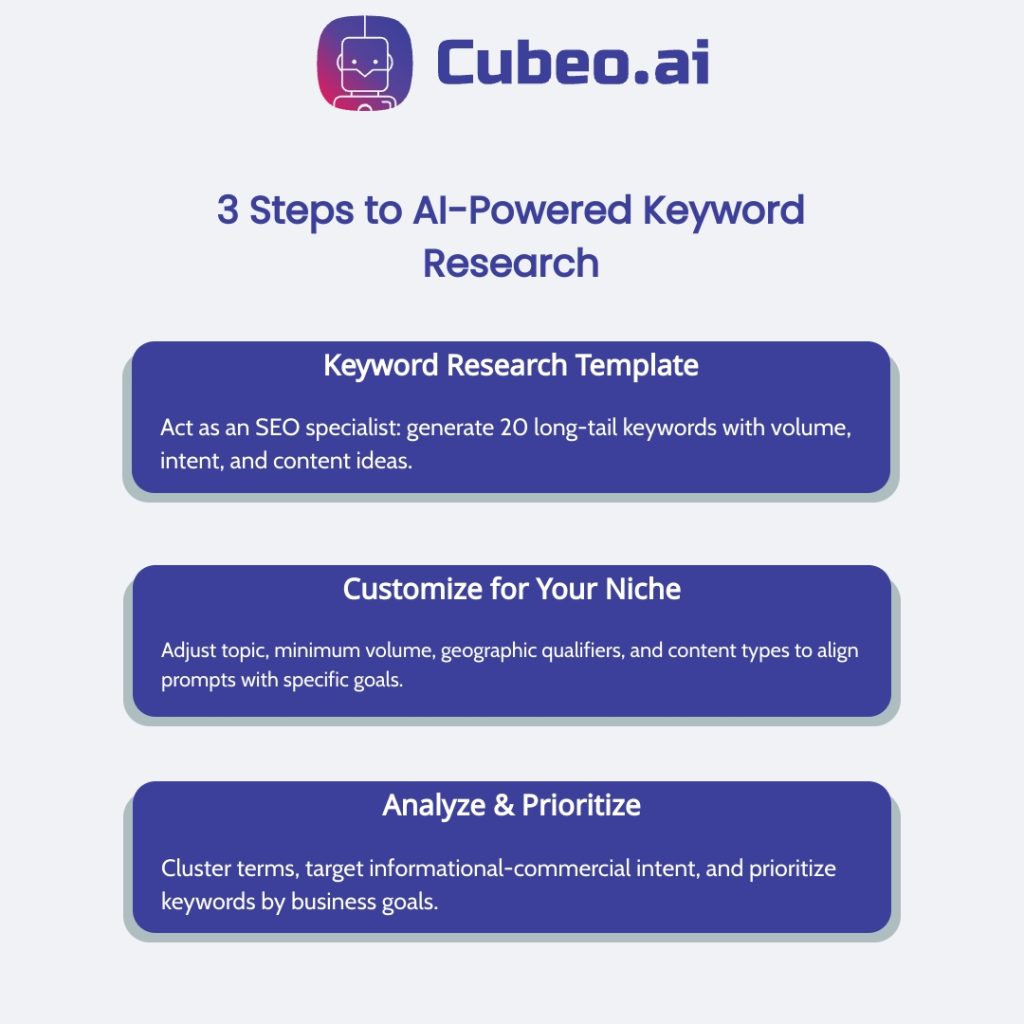
Prompt #2 Search Intent Analysis
The motivation behind searches matters more than the actual keywords. According to recent statistics, 52.65% of searches are informational, while only 0.69% are transactional, which basically shows why aligning content with intent drives on-page SEO success. This SEO AI prompt decodes search purposes:
Prompt Template:
Analyze the search intent behind these keywords: [LIST YOUR KEYWORDS].
For each keyword, provide:
- Primary intent classification (informational/navigational/commercial/transactional)
- Secondary intent (if applicable)
- User goal (what the searcher wants to accomplish)
- Content format recommendation (blog, product page, comparison guide, etc.)
- Three potential headlines that would satisfy this intent
Running this prompt with target keywords generates detailed user motivation insights. For instance, analyzing “best coffee makers 2025” reveals commercial intent with informational elements, suggesting a comparison guide would best serve users looking for purchase guidance.
Mapping Keywords to User Intent
Intent categorization helps prioritize content creation efforts. Group keywords by intent type, focusing first on informational queries since they represent the majority of searches. Research shows 88.1% of queries triggering AI Overviews are informational, making these extremely valuable for visibility.
Create a simple tagging system in your keyword database: “I” for informational, “N” for navigational, “C” for commercial, and “T” for transactional. This classification helps match keywords to appropriate content formats based on user journey position.
Optimizing Content Based on Intent Findings
After understanding intent patterns, structure your content accordingly. For informational queries, place comprehensive answers in the first paragraph to compete for featured snippets. Commercial intent keywords benefit from comparison tables, pros/cons lists, and clear recommendation sections.
Align your call-to-action buttons with intent signals. Informational content should guide readers toward related topics, while commercial pages should facilitate evaluation decisions. With more than 13% of queries now triggering AI Overviews, structuring content to directly address user questions has sort of become essential for maintaining search visibility.
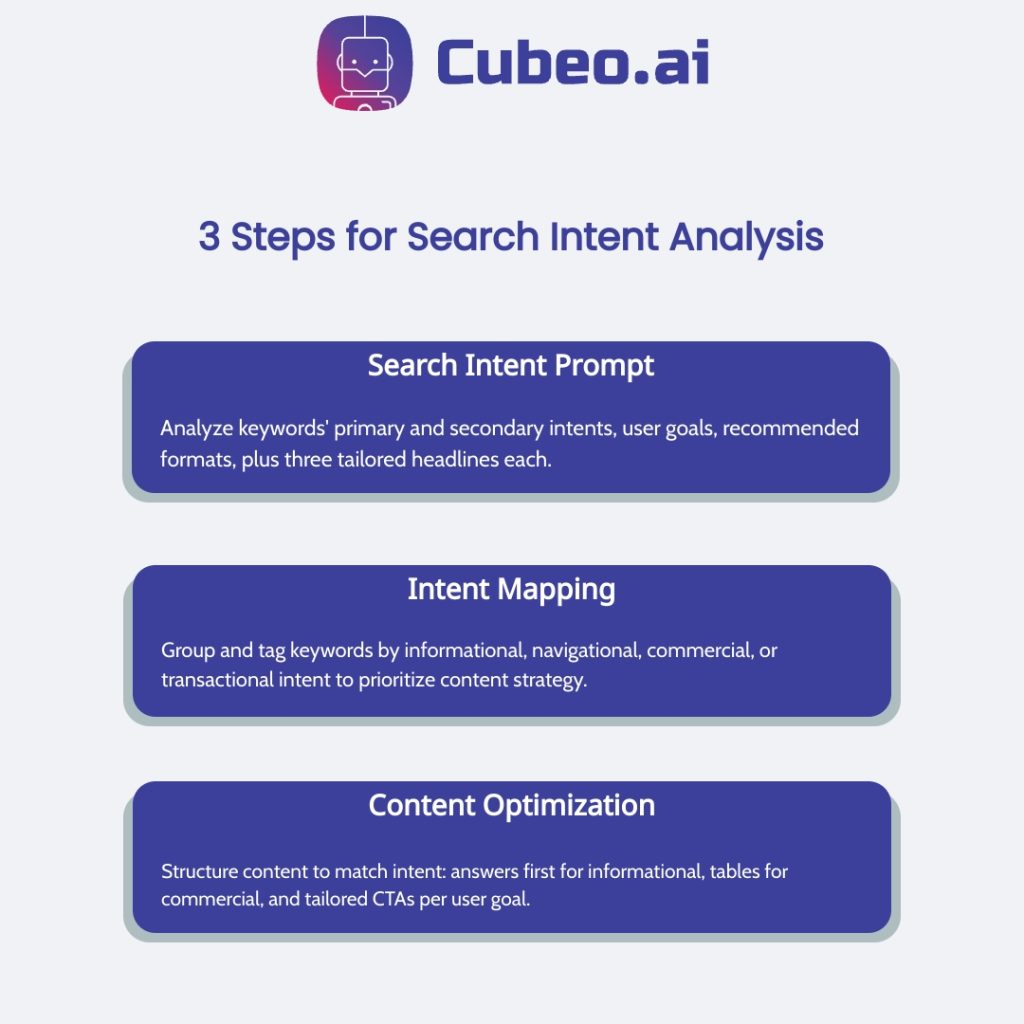
Prompt #3 Content Structure Optimization
Well-organized content boosts SEO performance and user experience significantly. According to 59.5% of websites lack H1 tags, a basic structural element search engines use to understand content. This third prompt helps you create organized, SEO-friendly content outlines:
Prompt Template:
Create a comprehensive content outline for a [CONTENT TYPE] about [TOPIC] targeting the keyword [PRIMARY KEYWORD]. Include:
- An engaging H1 title that includes the primary keyword
- 5-7 H2 sections that cover the most important subtopics
- 2-3 H3 subsections under each H2 where appropriate
- Bullet points listing key information to include in each section
- Suggestions for internal linking opportunities
Your resulting outline works as a content roadmap, ensuring logical flow and topic coverage. For instance, a blog about “sustainable gardening practices” might have H2 sections on composting, water conservation, and natural pest control—each with H3 subsections addressing specific techniques.
Creating SEO-Friendly Headers and Subheaders
Headers guide both readers and search engines through your content. Craft H1 tags that naturally include your primary keyword while accurately describing what readers will find. For H2 and H3 tags, use related keywords and questions your audience commonly asks.
Maintain a clear hierarchy where each level provides more specific details. This approach has proven effective, with companies like Flyhomes achieving 10,737% traffic growth in three months by implementing structured content strategies.
Balancing Readability and Keyword Optimization
Keywords matter, but readability remains essential. Keep sentences under 20 words where possible and vary sentence structure to maintain engagement. Break up text with bullet points, numbered lists, and short paragraphs for better scannability.
Avoid forcing keywords where they sound awkward. Instead, use semantic variations throughout your content. This approach aligns with modern search algorithms that understand topic relevance beyond exact matches. With 68% of all website traffic coming from search, finding the right balance directly affects your content’s performance.
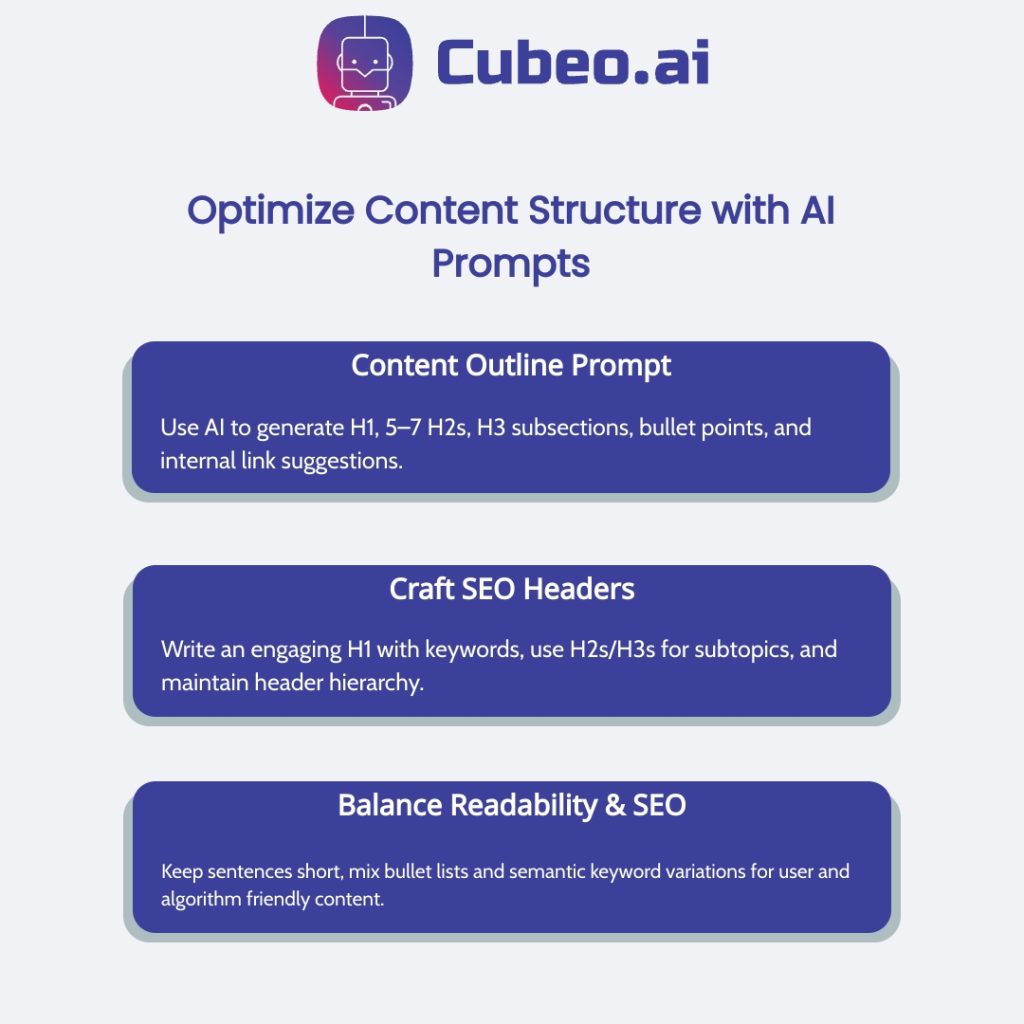
Prompt #4 Meta Description Generator
Meta descriptions serve as content advertisements in search results, directly affecting user click-through rates. Creating persuasive descriptions for each content piece requires time, but AI can actually speed up this process without sacrificing quality or effectiveness.
Prompt Template:
Generate 3 compelling meta descriptions for a [CONTENT TYPE] about [TOPIC] targeting the keyword [PRIMARY KEYWORD]. Each description should:
- Be between 140-155 characters
- Include the primary keyword naturally
- Contain a clear call-to-action
- Highlight a unique value proposition or benefit
- Create curiosity or urgency
This prompt delivers multiple options you can select or modify further. For example, a meta description about sustainable gardening might read: “Discover 7 sustainable gardening techniques that save water and reduce costs. Learn how to create an eco-friendly garden that thrives in any climate. Start today!”
Crafting Click-Worthy Meta Descriptions
Effective meta descriptions employ active voice and speak directly to readers for immediate engagement. According to best practices for writing meta descriptions, text between 150-160 characters prevents search result truncation while providing adequate space to communicate value.
Powerful calls-to-action such as “Discover,” “Learn,” or “Find out” create momentum toward clicking. In a way, phrases addressing specific pain points perform exceptionally well—”Stop wasting time” or “Save money while” connect with user motivations and boost engagement rates.
Incorporating Keywords Naturally in Meta Tags
Position your primary keyword within the first 50-70 characters when possible, as this enhances visibility and relevance signals. Keyword placement should never sacrifice readability or persuasiveness, though. The recommended character limit for meta descriptions spans from 70-160 characters, with 155 characters working best for most search displays.
Steer clear of keyword stuffing or awkward phrasing that sounds mechanical. Instead, basically use semantic variations and natural language that flows conversationally. Meta descriptions don’t directly impact rankings but significantly influence click-through rates, which indirectly affects overall SEO performance through user engagement metrics.
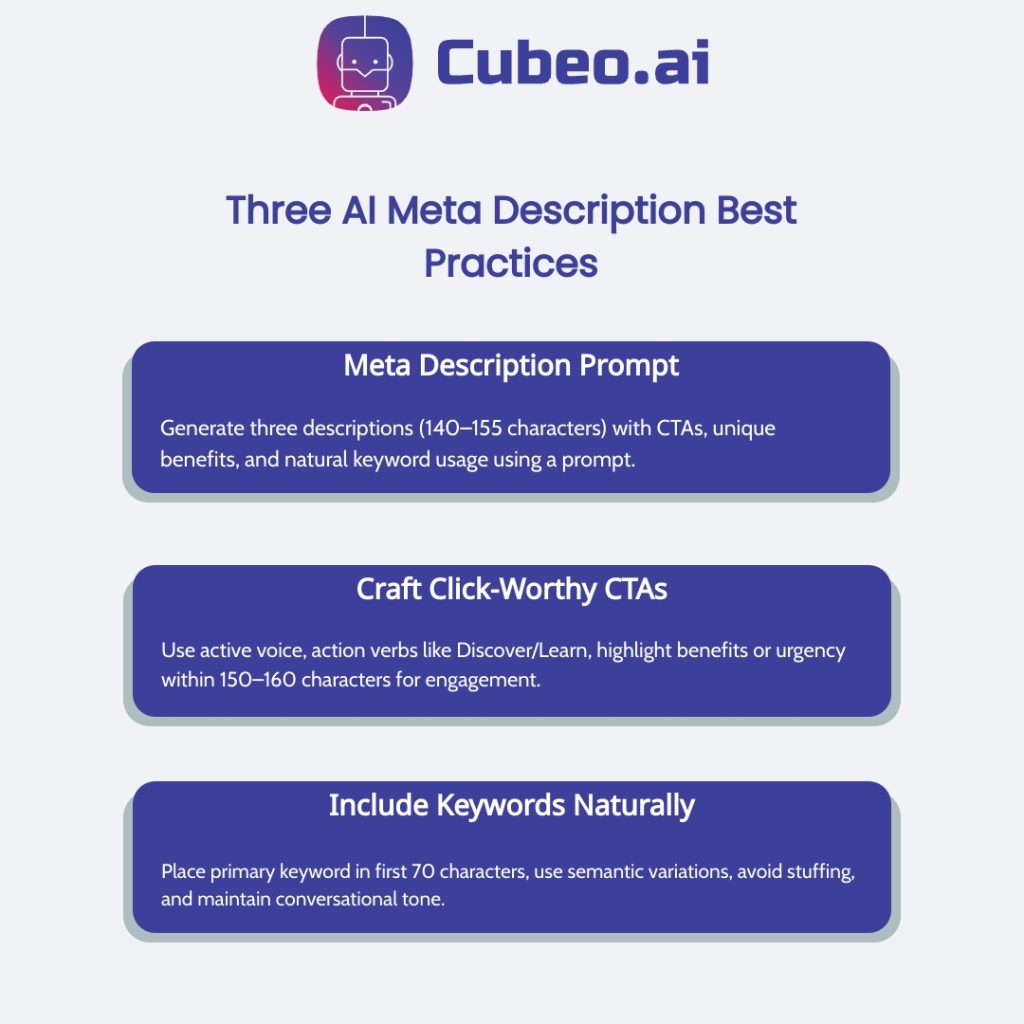
Prompt #5 Content Gap Analysis
Content gaps represent untapped ranking opportunities where competitors cover topics you don’t. Finding these gaps manually takes hours, yet AI speeds up this process considerably. A well-crafted content gap strategy produces remarkable results, as a matter of fact, a fertility clinic case study achieved a 95% increase in organic traffic after implementing gap-based content improvements.
Prompt Template:
Analyze the top 5 ranking pages for the keyword [TARGET KEYWORD] and identify content gaps. For each page:
- List the main topics and subtopics covered
- Identify unique angles or information each competitor includes
- Highlight important topics missing from multiple competitors
- Suggest 10 content opportunities based on these gaps
- Rank these opportunities by potential impact (high/medium/low)
Running this prompt with your target keyword generates a comprehensive analysis of competitor content. Analyzing “home office setup” might reveal competitors cover desk ergonomics and lighting but rarely address soundproofing or video backgrounds—presenting clear content opportunities.
Identifying Missed Opportunities in Your Content
Effective gap analysis requires systematic comparison between your content and top-performing competitors. According to a guide on content gap analysis, you should examine keyword coverage, content depth, format variety, and user intent alignment.
Look for subtopics appearing consistently across competing pages but missing from yours. Track questions in featured snippets or “People Also Ask” sections, which represent direct user queries. Create a spreadsheet to visualize these gaps across your content ecosystem.
Creating a Content Plan Based on Gaps
Transform your gap analysis into an actionable calendar by prioritizing topics with high search volume and business relevance. Start with quick wins—enhancing existing pages rather than creating entirely new content.
Set realistic publishing schedules based on content complexity and available resources. A strategic approach to filling content gaps can, in some respects, produce exceptional results, similar to the 73% increase in search visibility achieved in the fertility clinic example. Focus first on gaps related to commercial-intent keywords supporting conversion goals, then expand to informational content.
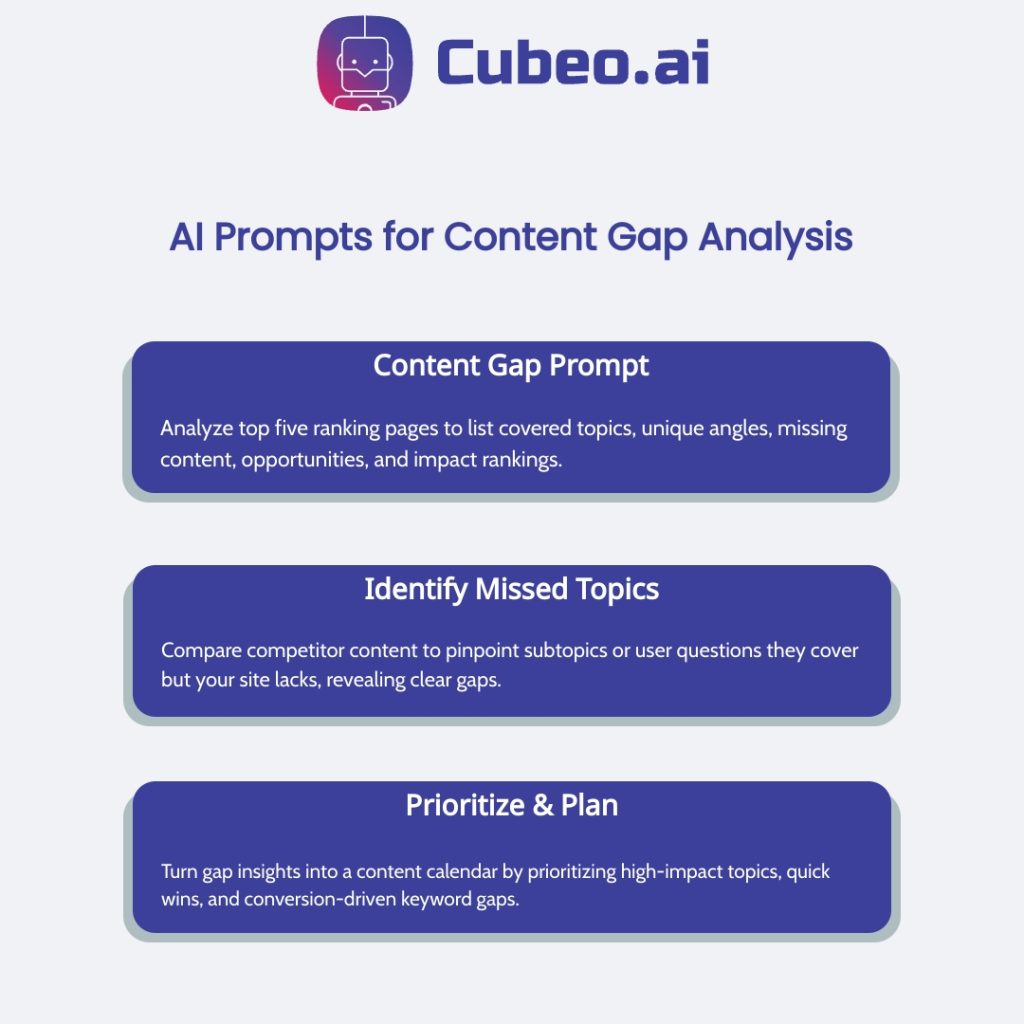
Prompt #6 FAQ Generation for Schema Markup
FAQ sections work for two key purposes—answering user questions and creating opportunities for better search visibility through schema markup. When implemented correctly, FAQ schema can boost performance dramatically, as shown in a case study reporting a 9,210% increase in clicks from 38 to nearly 3,500 monthly. Generative AI tools create comprehensive FAQ sections customized for your content needs.
Prompt Template:
Generate 10 frequently asked questions about [TOPIC] for FAQ schema markup. For each question:
- Provide a clear, concise question using natural language
- Write a 2-3 sentence answer that provides valuable information
- Include relevant keywords naturally in both questions and answers
- Ensure answers are factually accurate and helpful
- Cover different aspects of the topic to maximize topical coverage
The FAQs generated can be added directly to your page with schema markup. A page about “sustainable gardening” might, for example, include questions such as “What are the best drought-resistant plants for beginners?” and “How can I create compost from kitchen waste?”—each with informative, targeted answers.
Implementing FAQ Schema for Better Visibility
Adding structured data tags to FAQs tells search engines your content answers specific questions, potentially earning enhanced listings in search results. Businesses using schema achieve higher click-through rates and improved rankings through these rich results.
After adding your AI-generated FAQs, you should validate the markup with Google’s Rich Results Test tool to ensure proper formatting. Place FAQ sections strategically on the page—typically after main content but before conclusions—to maximize engagement without disrupting the primary content flow.
Targeting Long-Tail Keywords with FAQs
FAQ sections capture niche, long-tail search queries that might be difficult to target in main content. Focus on specific questions your audience actually asks, particularly those with commercial intent that could drive conversions.
Voice search optimization represents another benefit of well-crafted FAQs. Since voice queries typically use natural question formats, your FAQ schema positions content to capture this growing search segment. The impact can be substantial—the implementation case study mentioned earlier saw impressions increase to over 235,000 with CTR improving from 0.1% to 1.3%, demonstrating the significant visibility boost FAQ schema provides.
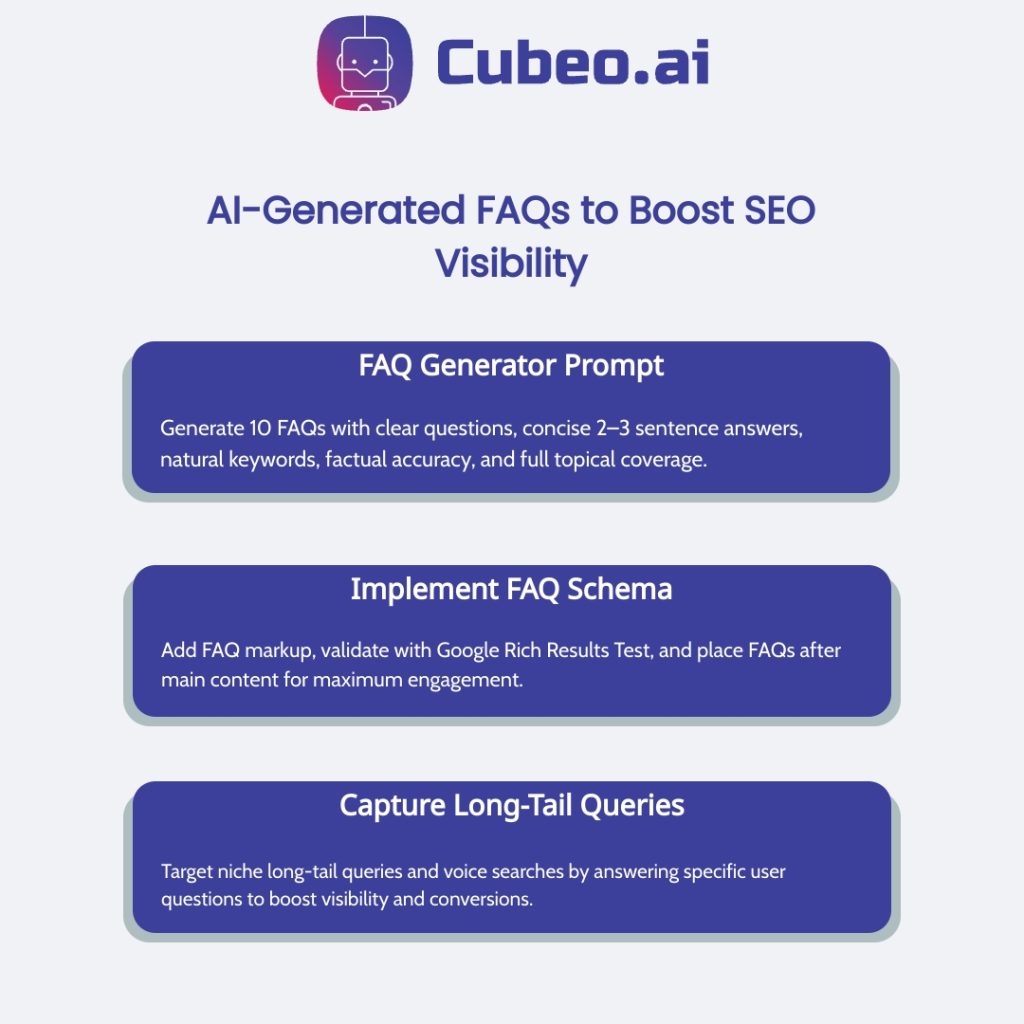
Prompt #7 Internal Linking Strategy
Strong internal linking builds effective site architecture, distributing authority throughout your content ecosystem. Many websites lack strategic linking patterns, missing valuable connection opportunities. This prompt identifies smart internal linking possibilities that benefit search engines and users alike.
Prompt Template:
Analyze the article titled [ARTICLE TITLE] about [TOPIC] and suggest 5-7 internal linking opportunities. For each suggestion:
- Identify a specific phrase or sentence where a link could be added
- Recommend relevant anchor text (3-5 words)
- Describe what type of content the link should point to
- Explain the SEO and user experience benefit of this particular link
This approach generates contextual linking recommendations tailored to your content. An article about “email marketing automation” might receive suggestions to link phrases like “segmentation strategies” to related guides, with explanations of how each link strengthens topical clusters and helps users discover more resources.
Optimizing Site Structure with Strategic Links
Effective internal linking creates clear pathways for search engines and users to navigate your content. According to best practices for internal linking, descriptive anchor text with relevant keywords improves how search engines understand content relationships.
Focus on creating links to pillar content—comprehensive resources that serve as foundations for topic clusters. This approach helps search engines recognize your site’s authority while providing logical navigation paths. In a way, limiting links to truly relevant pages prevents reader confusion and preserves link equity.
Improving User Experience Through Internal Links
Strategic internal links keep visitors engaged by guiding them to related information. This natural content journey increases session duration and pages per visit while reducing bounce rates—all positive signals that benefit SEO performance.
The importance of internal linking for SEO extends beyond technical benefits to impact conversion rates. By connecting users with relevant resources at moments of interest, you create smoother paths to conversion. Too often, websites place links randomly rather than at points where users might have questions, so a thoughtful approach ensures links serve as helpful navigation aids.
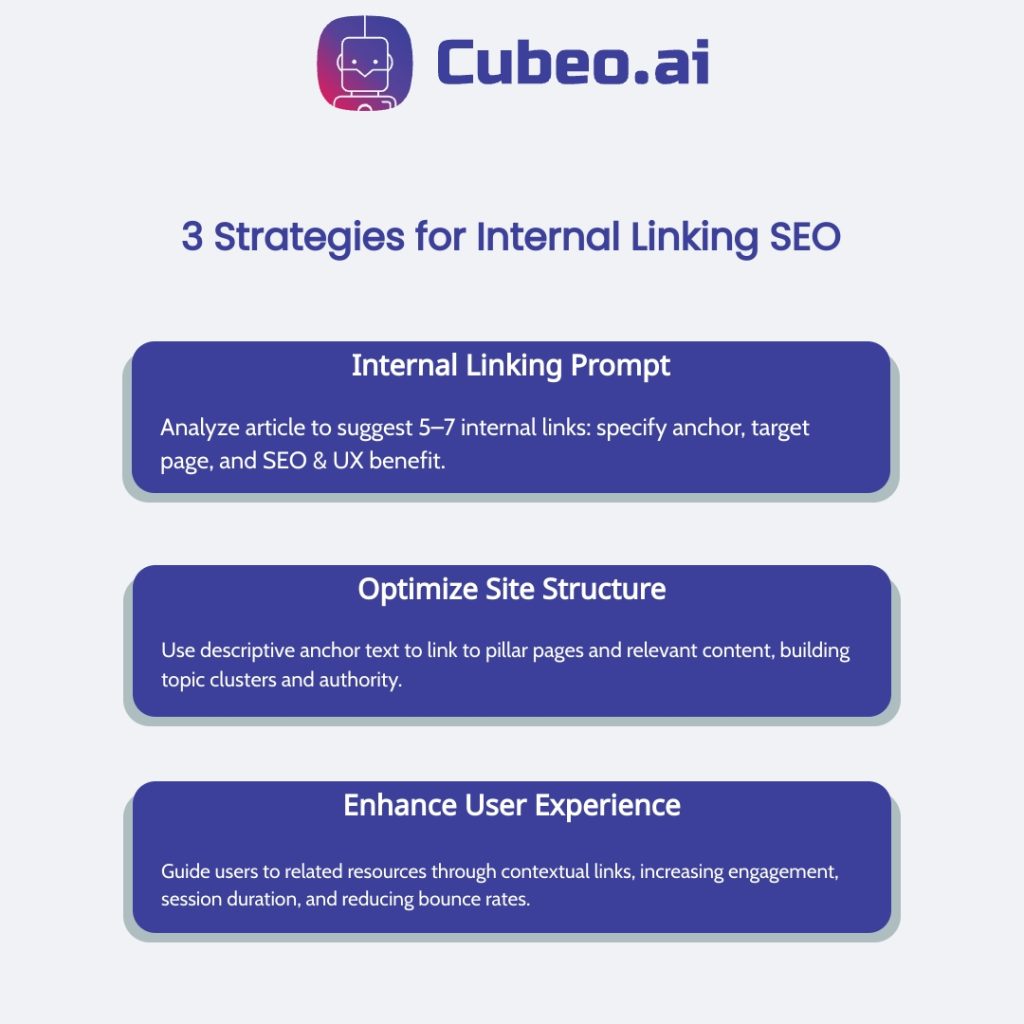
Prompt #8 Title Tag Optimization
Title tags serve as your content’s first impression in search results, directly affecting whether users click your page. Effective titles can improve click-through rates by 20-50%, making them crucial for on-page SEO success. This prompt helps create multiple compelling title options:
Prompt Template:
Generate 7 optimized title tag variations for an article about [TOPIC] targeting the keyword [PRIMARY KEYWORD]. For each title:
- Keep character count between 50-60 characters
- Place the primary keyword near the beginning
- Include a number or specific benefit where appropriate
- Use emotional triggers (curiosity, urgency, value)
- Explain why this title would appeal to the target audience
The resulting variations provide several options to test. For a guide about “beginner gardening tips,” titles might range from “7 Essential Gardening Tips for Beginners (Start Today!)” to “Beginner Gardening Guide: Transform Your Yard in 30 Days.”
Balancing SEO and Click-Through Rate in Titles
Powerful titles combine keyword optimization with psychological triggers that encourage clicks. Numbers create specificity—”5 Ways” or “30-Day” perform better than vague promises. Words like “essential,” “proven,” or “ultimate” signal value to readers scanning results.
Character limits matter too. Titles over 60 characters might get cut off in search results, potentially hiding key information. Titles between 50-60 characters achieve optimal visibility while providing enough space for both keywords and compelling language, creating a balance between SEO needs and user appeal.
A/B Testing Title Variations for Better Performance
Title tag adjustments can yield surprising results. A case study found that simply adding the word “best” to title tags increased organic sessions by 11%, showing how small changes impact performance.
Start by defining clear success metrics—typically click-through rate and conversion impact. Run tests for at least two weeks to gather sufficient data, especially for lower-traffic pages. Tools like Google Search Console help track CTR changes, while more advanced platforms enable automated title rotation. Focus on testing one element at a time (word choice, numbers, question format) to identify what drives improvements in your specific niche.
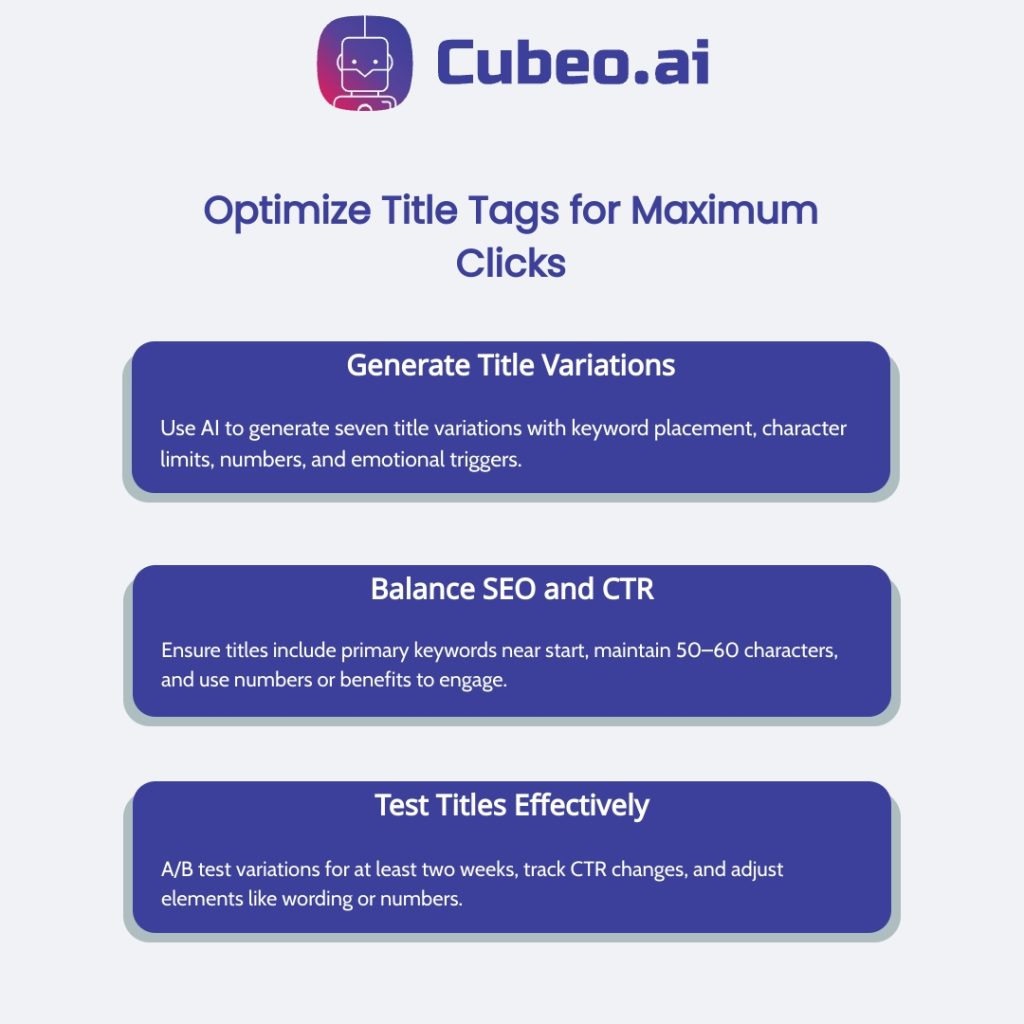
Prompt #9 Competitor Content Analysis
Competitors provide valuable shortcuts to SEO success when analyzed properly. This AI prompt extracts structured insights from top-ranking content without spending hours manually reviewing each page. The analysis reveals proven strategies and highlights gaps where your content can excel.
Prompt Template:
Analyze the top 3 ranking articles for the keyword [TARGET KEYWORD]. For each article:
- Summarize the main content approach and structure
- Identify content strengths (depth, examples, visuals, data)
- Note potential weaknesses or missing information
- Extract the approximate word count and content format
- Suggest 3 specific ways to create superior content on this topic
Running this prompt for “seo ai prompts” or similar keywords delivers a competitive landscape snapshot in minutes. You might discover competitors excel at theoretical explanations but lack practical chatgpt seo examples—creating a clear opportunity for your content to stand out with actionable templates.
Identifying Competitor Content Strengths and Weaknesses
Effective analysis requires a systematic approach to competitor analysis examining both structure and performance metrics. Review content length, format diversity, and information organization to understand audience preferences.
Engagement indicators like comments, shares, and backlinks reveal which elements generate interest. Content gaps often represent your best opportunities for differentiation. Quantitative metrics provide objective data about which strategies deserve adoption versus areas where innovation would benefit your approach.
Creating Superior Content Based on Competitor Analysis
Transform insights into content improvements by addressing identified weaknesses. When competitors offer shallow coverage, create comprehensive guides with exceptional depth. If visual elements are lacking, add infographics or videos to enhance understanding.
Understanding competitors’ SEO tactics reveals which keywords drive traffic and which formats perform best. Target underserved subtopics where existing content fails to satisfy user intent. Focus on creating materials that serve multiple stages of the buyer journey to capture traffic competitors miss by focusing too narrowly on a single funnel stage.
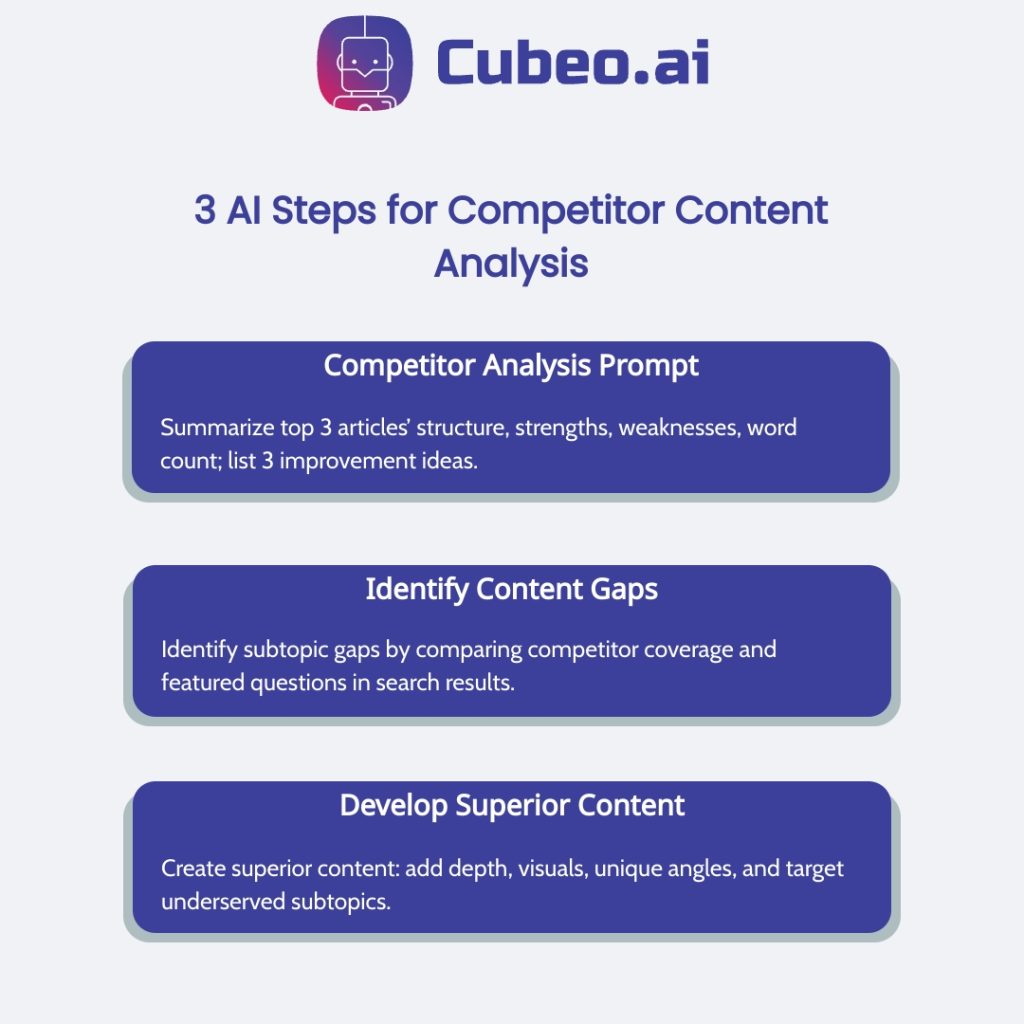
Prompt #10 Technical SEO Audit Checklist
Technical SEO problems often lurk beneath the surface, quietly preventing websites from reaching their potential. Running a thorough audit exposes these hidden ranking barriers. Research shows addressing these technical roadblocks can yield remarkable results—one website experienced an 850% improvement in site health score after implementing fixes from a comprehensive audit.
Prompt Template:
Create a comprehensive technical SEO audit checklist for a [WEBSITE TYPE] website. Include:
- Critical crawlability and indexing checks
- Site speed optimization opportunities
- Mobile usability factors
- Structured data implementation checks
- Security and HTTPS verification
- URL structure and internal linking assessment
- Prioritize each item as high/medium/low impact
This type of prompt works best with retrieval-augmented generation methodology that connects AI responses to current technical SEO standards. Using RAG for context-aware AI minimizes inaccuracies during technical audits by grounding responses in verified data rather than relying on potentially outdated training information.
Prioritizing Technical SEO Issues
Start by tackling elements directly affecting crawlability—these create the foundation for search visibility. Give mobile usability immediate attention due to Google’s mobile-first approach. Speed issues need quick resolution since a single second delay can decrease conversions by 7%.
Organize fixes based on effort versus impact. Focus on high-impact, low-effort improvements first, then address critical issues regardless of complexity. This method ensures your resources target changes with maximum return potential.
Implementing Technical Fixes for Better Rankings
Begin with core improvements to site structure and crawlability. Optimize header tags for proper content hierarchy and add schema markup to enhance search appearances. Fix redirect chains and broken links quickly—the Seattle case study showed reducing error pages from 7,817 to 616 significantly boosted performance.
For larger websites, implement fixes in phases, starting with high-traffic sections. Track all changes to measure their impact on rankings and organic traffic, creating a data-driven approach that guides future technical optimization strategies.



